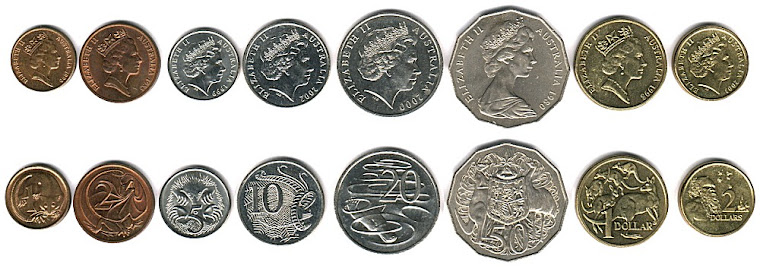Australian Dollar
The Australian dollar (Represented by AUD, also written A $, AU $, $ A $ or AU) is the official currency of the Commonwealth of Australia, including the Australian Antarctic Territory, Christmas Island, Cocos (Keeling) Islands, Heard Island Island and McDonald Islands and Norfolk, as well as independent islands of Kiribati and Tuvalu in the Pacific. It is sometimes called the "Aussie battler", during a short period, between 2001 and 2002, the currency was called locally, "Pacific Peso". It is subdivided into 100 cents (symbol c).
The Australian dollar is the sixth most widely used currency in foreign trade (besides the U.S. dollar, yen, euro, pound sterling and Canadian dollar) giving an account of about 4-5% of foreign transactions. The Australian dollar is popular with currency traders due to lack of government intervention in the foreign market, the overall stability of the economy and government, and believes that it offers diversification benefits to a folder containing the major world currencies (for example because of greater exposure to Asian economies and the cycle of goods (commodities).
History of the Dollar
The Australian dollar was introduced in 1966, not only to replace the Australian pound (distinct from the pound sterling), but also introducing a decimal system. Prime Minister Robert Menzies wished to name the currency "Royal" (Royal), and other names such as "Southern" were also proposed.
Because the influence of Menzies, the name "Royal" was accepted, and the drawings were prepared and printed in the Reserve Bank of Australia (Reserve Bank of Australia). The unusual choice of name for the currency proved unpopular, and was later retired in favor of "Dollar" (Dollar).
On February 14, 1966, the Australian dollar was introduced with the value of two dollars a pound or ten shillings to the dollar.
Tradução
Dólar australiano
O Dólar Australiano (Representado por: AUD, também grafado A$, AU$, $A ou $AU ) é a moeda oficial da Comunidade da Austrália, incluindo o Território Antártico Australiano, a Ilha Christmas, Ilhas Cocos (Keeling), Ilha Heard e Ilhas McDonald e Ilhas Norfolk, assim como as ilhas independentes de Quiribati e Tuvalu, no Pacífico. É algumas vezes chamado "Aussie battler"; durante um pequeno período, entre 2001 e 2002, a moeda corrente foi chamada, localmente, "Pacific Peso". É subdividida em 100 cents (symbol c).
O dólar australiano é a sexta moeda mais usada no comércio estrangeiro (além do dólar americano, do iene, do euro, da libra esterlina e do dólar canadense) dando conta de aproximadamente 4-5% das transações estrangeiras. O Dólar australiano é popular com os comerciantes de moedas devido a falta de intervenção do governo no mercado estrangeiro, a estabilidade geral da economia e do governo, e considera que ele oferece benefícios de diversificação em uma pasta contendo as maiores moedas correntes do mundo (por exemplo por causa da maior exposição às economias asiáticas e o ciclo de mercadorias (commodities).
História do Dólar
O Dólar australiano foi introduzido em 1966, não somente para substituir a libra australiana (distinta da libra esterlina), mas também introduzindo um sistema decimal. O Primeiro Ministro Robert Menzies desejava nomear a moeda "Royal" (Real), e outros nomes tais como "Austral" foram também propostos.
Devido a influência de Menzies, o nome "Royal" foi aceito, e os desenhos foram preparados e impressos no Reserve Bank of Australia (Banco de Reserva da Austrália). A escolha incomum do nome para a moeda provou-se impopular, e foi mais tarde aposentada em favor do "Dollar" (Dólar).
Em 14 de Fevereiro de 1966, o Dólar australiano foi introduzido com o valor de Dois dólares por uma libra ou dez shillings por dólar.
